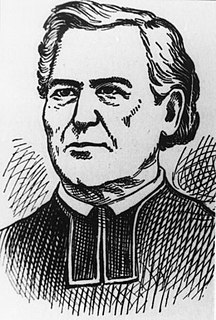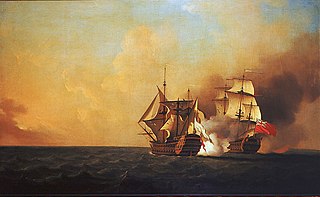Joseph Leblanc dit Le Maigre (March 12, 1697 – October 19, 1772) was an Acadian farmer and trader who took part in several attempts by the French to recover their holdings in what is now Nova Scotia. [1]

Nova Scotia is one of Canada's three Maritime Provinces, and one of the four provinces that form Atlantic Canada. Its provincial capital is Halifax. Nova Scotia is the second-smallest of Canada's ten provinces, with an area of 55,284 square kilometres (21,300 sq mi), including Cape Breton and another 3,800 coastal islands. As of 2016, the population was 923,598. Nova Scotia is Canada's second-most-densely populated province, after Prince Edward Island, with 17.4 inhabitants per square kilometre (45/sq mi).
The son of Antoine Leblanc and Marie Bourgeois, he was born in Les Mines (near Wolfville, Nova Scotia) in Acadia. In 1719, Leblanc married Anne, the daughter of Alexandre Bourg. He owned a farm and raised cattle near Grand-Pré. Leblanc took part in the siege against Annapolis Royal led by François Dupont Duvivier in 1744. Although the British interrogated him about his part in the affair, he was able to plead ignorance. However, after he assisted Paul Marin de la Malgue in a new attack in the summer of 1745, Leblanc was imprisoned at Annapolis Royal. Leblanc escaped and provided provisions to a large French fleet led by Jean-Baptiste Louis Frédéric de La Rochefoucauld de Roye, who intended to recapture Acadia and Île-Royale. After the failure of this expedition, Leblanc was captured and sent to Boston. He escaped but was forced to flee again after the British authorities discovered his presence. After Île-Royale was returned to France at the end of the War of the Austrian Succession, Leblanc settled at Port-Toulouse. [1] [2]

Acadia was a colony of New France in northeastern North America that included parts of eastern Quebec, the Maritime provinces, and modern-day Maine to the Kennebec River. During much of the 17th and early 18th centuries, Norridgewock on the Kennebec River and Castine at the end of the Penobscot River were the southernmost settlements of Acadia. The actual specification by the French government for the territory refers to lands bordering the Atlantic coast, roughly between the 40th and 46th parallels. Later, the territory was divided into the British colonies that became Canadian provinces and American states. The population of Acadia included members of the Wabanaki Confederacy and descendants of emigrants from France. The two communities intermarried, which resulted in a significant portion of the population of Acadia being Métis.
Alexandre Bourg dit Belle-Humeur was a notary and King's attorney living in what is now Nova Scotia, Canada.

Grand-Pré is a Canadian rural community in Kings County, Nova Scotia. Its French name translates to "Great/Large Meadow" and the community lies at the eastern edge of the Annapolis Valley several kilometres east of the town of Wolfville on a peninsula jutting into the Minas Basin surrounded by extensive dyked farm fields, framed by the Gaspereau and Cornwallis Rivers. The community was made famous by Henry Wadsworth Longfellow's poem Evangeline and is today home to the Grand-Pré National Historic Site. On June 30, 2012, the Landscape of Grand-Pré was named a World Heritage Site by UNESCO.
After Louisbourg fell in 1758, for a time Leblanc operated as a pirate in the Gulf of Saint Lawrence. The British confiscated his possessions and imprisoned him at Halifax. After his release, Leblanc went to Miquelon. His wife died in July 1766 and, soon afterwards, he moved to the island of Belle Île in France, where he lived in the village of Kervaux. Leblanc died there at the age of 75. [1] [2]

Louisbourg is an unincorporated community and former town in Cape Breton Regional Municipality, Nova Scotia.

The Gulf of Saint Lawrence is the outlet of the North American Great Lakes via the Saint Lawrence River into the Atlantic Ocean. The gulf is a semienclosed sea, covering an area of about 226,000 square kilometres (87,000 sq mi) and containing about 34,500 cubic kilometres (8,300 cu mi) of water, which results in an average depth of 152 metres (499 ft).

Miquelon-Langlade is the larger and less populated of the two communes (municipalities) making up the French overseas collectivity of Saint Pierre and Miquelon, located to the south of Newfoundland in the Gulf of St. Lawrence. It consists of three geological islands: Miquelon, Langlade and Le Cap, connected with tombolos. The communal seat is the settlement of Miquelon, on the northern tip, where the entire island's permanent population of 623 is located. Miquelon Airport provides flights to Montreal and to nearby Saint-Pierre.
His daughter Marguerite married Joseph Dugas, an Acadian merchant and privateer. [3]
Joseph Dugas was a merchant, privateer and militia officer of Acadian descent.








